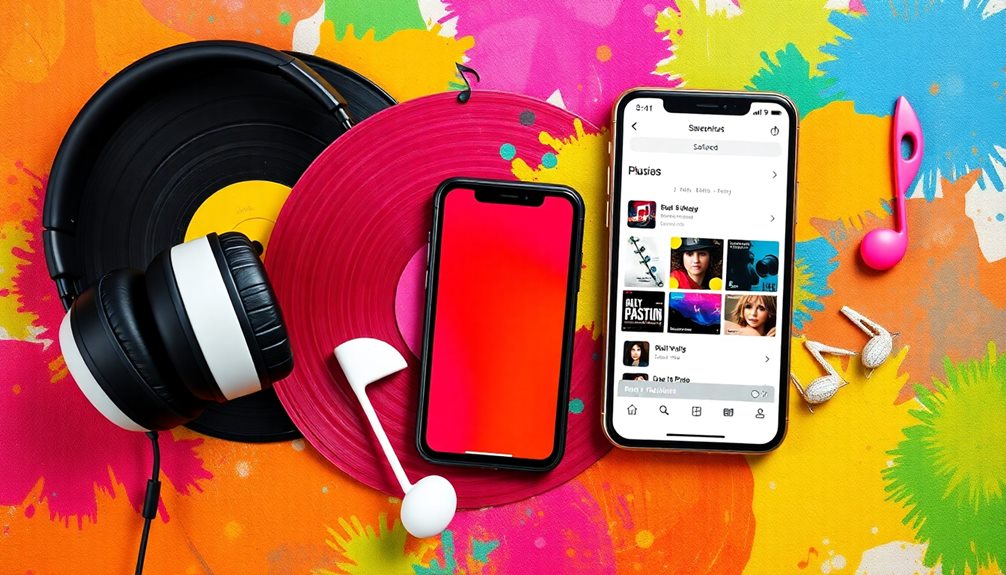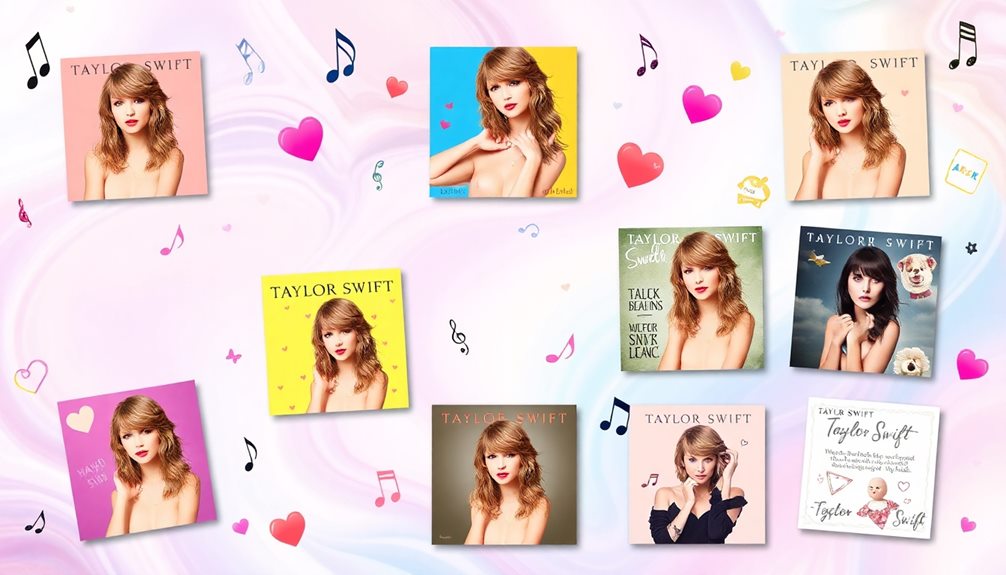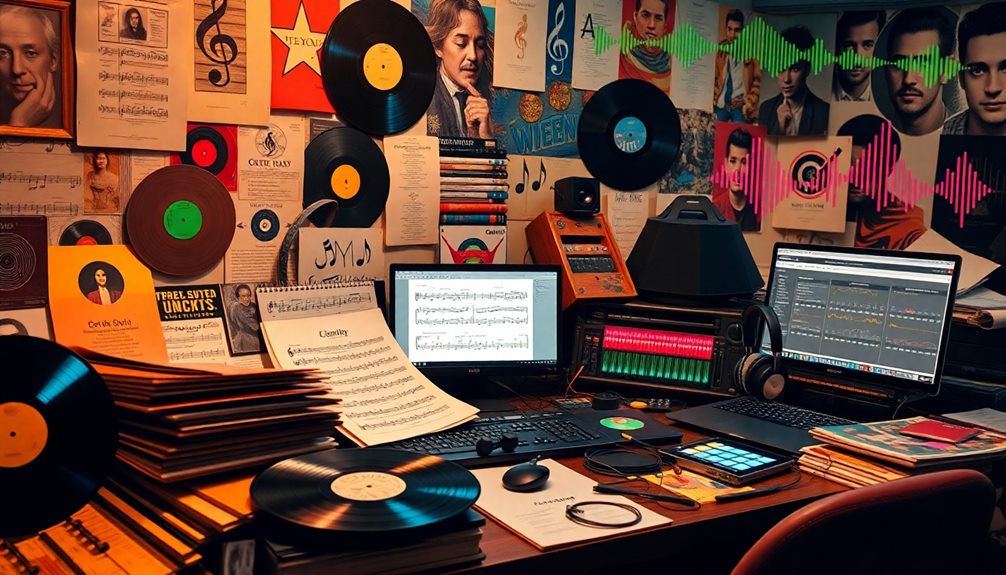Getting your music onto Spotify is super exciting! First, you'll want to choose a distributor like DistroKid or TuneCore. These services help you upload your tracks and guarantee they reach the right channels. Make sure to polish your songs and gather all the important details like titles and genre tags. Then, promote your music using social media and connect with playlist curators since many listeners find new songs this way. Finally, set up a profile on Spotify for Artists to track your performance and connect with fans. Stick around, and you'll uncover more tips to make your music shine!
Key Takeaways
- Choose a suitable distributor based on pricing models, such as flat fees or per-release charges, to align with your financial strategy.
- Prepare your music by mastering tracks and gathering accurate metadata to enhance discoverability across streaming platforms.
- Promote your music through curated playlists and social media engagement, as 60% of listeners discover new songs this way.
- Utilize Spotify for Artists to manage your profile, track performance metrics, and pitch for playlist placements effectively.
- Network with other artists and industry professionals to explore collaboration opportunities and enhance your music's reach.
Understanding Music Distribution
When it comes to getting your music heard, understanding music distribution is key. Music distribution services help you distribute your music to popular streaming platforms like Spotify and Apple Music. These services make it easy for you to upload your tracks and manage them all in one place.
You can choose DIY distributors like DistroKid or TuneCore, which let you keep your rights and control while charging flat fees or per-release costs.
One exciting benefit of using a music distributor is their help with Spotify playlists. Did you know that around 60% of listeners find new music through playlists? Getting on one can really boost your visibility!
Accurate metadata is also super important. Think of it as the information that tells platforms what your music is all about, including track titles and genre tags. This helps improve how easily others can discover your tunes.
Using a music distributor not only simplifies getting your music out there but also helps you track how well your songs are doing. So, immerse yourself in music distribution and start sharing your sound with the world!
Choosing the Right Distributor
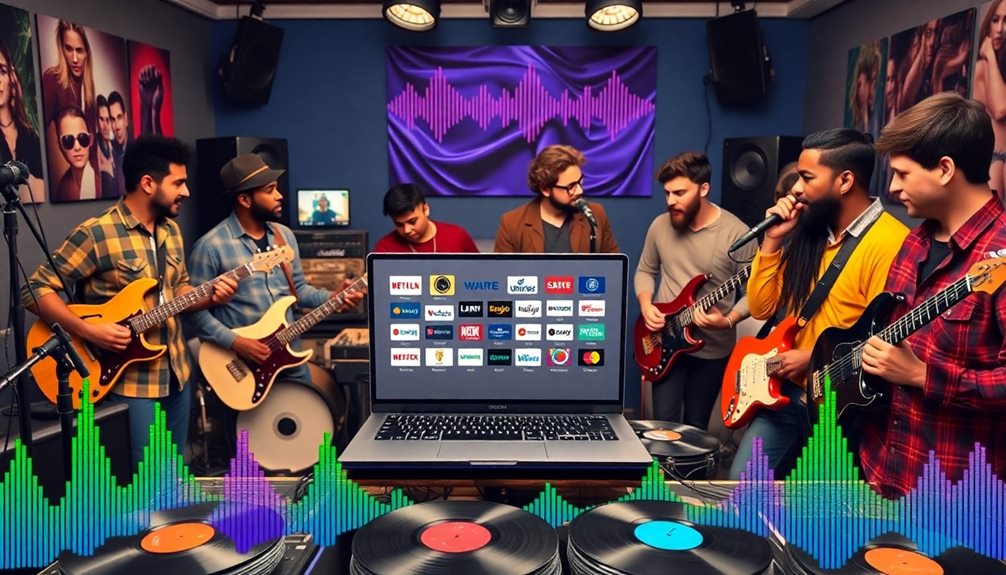
Choosing the right distributor is super important for getting your music heard!
You'll want to look at how much they charge, like whether they've a flat fee or charge per song.
Plus, checking out the services they offer can help you find the best fit for your music journey!
Pricing Models Explained
Steering through the world of music distribution can feel overwhelming, especially with various pricing models available to you. Understanding these options helps you choose the right distribution company for your needs.
One popular choice is flat-rate pricing. Distributors like DistroKid let you upload unlimited tracks for a flat annual fee, around $20. This is great if you have lots of music!
On the other hand, some services charge per-release. For example, CD Baby charges $5 for a single and $20 for an album. This could be better for you if you release music less often.
Another option is revenue percentage models. Platforms like AWAL and Stem take a small cut from your earnings, usually around 15% or 5%. This might be appealing if you prefer not to pay upfront fees.
However, if you're serious about your music, consider TuneCore. They charge $30 for the first year and $50 after, but you keep 100% of your earnings!
Services Offered Comparison
Steering through the various services offered by music distributors can greatly impact your success as an artist.
When you choose the right distributor for your music distribution needs, you set yourself up for a brighter future. Here are some aspects to take into account:
- Pricing Models: Some, like DistroKid, let you release music for a flat annual fee, while others, like TuneCore, charge per release.
- Revenue Retention: With TuneCore, you keep 100% of your earnings, but AWAL takes a 15% cut from your sales.
- Global Reach: Distributors such as CD Baby and Ditto Music can help you get your music on platforms beyond just Spotify.
- Additional Services: Some distributors offer cool features like playlist pitching and detailed analytics to boost your promotional efforts.
- Support and Resources: If you're just starting out, CD Baby provides personal support and guidance to help you navigate music distribution.
Preparing Your Music for Release

Preparing your music for release involves careful planning and attention to detail. Start by developing a clear vision for your release. Think about its theme and decide whether you want to share a single, an EP, or a full album. This helps you organize your music effectively.
When you finalize your tracks, make certain the strongest ones are first. This creates a great first impression for your listeners!
Next, gather all the necessary information for music distribution. Accurate titles, credits, and metadata are essential for proper categorization on platforms like Spotify. This guarantees your music is discoverable.
Don't forget to master your tracks! This step optimizes loudness and clarity, making your music sound amazing on various playback systems. Consider using professional mastering services or AI tools like LANDR to get the best results.
Promoting Your Tracks Effectively

Promotion is the lifeblood of your music's success. To get your tracks noticed on Spotify, you need to get creative and strategic. Here are some effective ways to promote your music:
Utilizing curated playlists can help you reach a wider audience, similar to how live music enhances the dining experience at best restaurants with live music. About 60% of Spotify users discover new music this way, so aim to get your tracks featured.
- Utilize curated playlists: About 60% of Spotify users discover new music this way, so aim to get your tracks featured.
- Engage on social media: Share your music and playlists on platforms like Instagram and Twitter. This helps you connect with fans and grow your audience.
- Build relationships with curators: Personalize your outreach to playlist curators. A friendly message might get you noticed, unlike a generic one.
- Stick to a release schedule: Launching your music on Fridays can maximize exposure since listeners are hunting for new tunes.
- Track your performance: Use Spotify for Artists to see who's listening and how they engage with your music. This data can help you refine your promotional efforts.
Utilizing Spotify for Artists
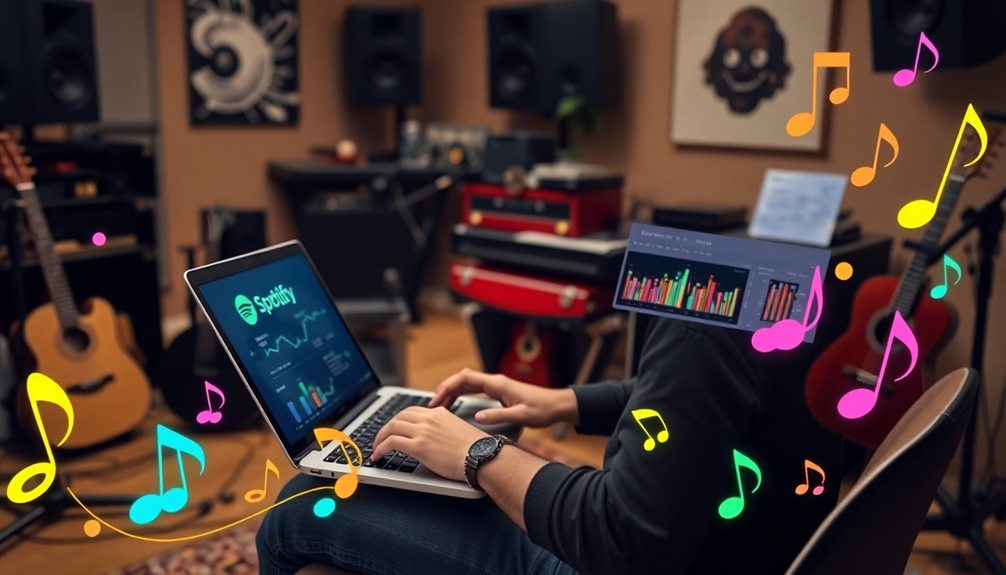
Getting started with Spotify for Artists is super exciting!
You can set up your profile to show off your music, and it gives you a chance to connect with your fans.
Plus, by analyzing performance metrics, you'll discover what works best for your songs and how to reach even more listeners.
Setting Up Your Profile
Setting up your Spotify for Artists profile is an essential step for any musician looking to connect with fans and showcase their work effectively. Once you've released your first track, claim your profile. This helps you manage your Artist Profile and engage with listeners.
Here's what you can do:
- Set your artist image: Use a high-quality photo that represents you and your music.
- Update your bio: Share your story and what inspires your music.
- Showcase your music visually: Create eye-catching visuals to attract more listeners.
- Pitch for playlist placements: Use the promotional tools available to get your music noticed. It's best to pitch 14 days before your release.
- Interact with your audience: Share updates and respond to fan messages to build a loyal community.
With Spotify for Artists, you can take control of your distribution journey, making it easier for fans to discover your music.
Plus, you can gather insights to refine your marketing strategies. Immerse yourself, and let your music shine!
Analyzing Performance Metrics
As you initiate your music career, analyzing performance metrics with Spotify for Artists can be a game changer. This powerful tool helps you understand your audience better by providing detailed analytics. You can see how many streams your songs get, who's listening, and even where they're from!
Tracking your performance in real-time means you can adjust your marketing strategies quickly. For instance, if you notice a spike in listeners from a specific area, you might want to plan a show there.
Did you know that about 60% of users discover new music through curated playlists? Understanding this can help you focus your efforts on getting featured.
By analyzing engagement rates and listener trends, you'll discover which songs resonate best with your fans. This insight is super helpful for planning future music releases!
Regularly reviewing these performance metrics keeps you informed and helps refine your promotional efforts.
Analyzing Performance Metrics

Understanding performance metrics is essential for artists looking to maximize their impact on Spotify. By analyzing the analytics provided through Spotify for Artists, you can get a clear picture of how your music is doing. You'll discover important metrics like streams, listener demographics, and geographic data that help you understand your audience better.
Here are some key performance aspects to keep in mind:
- Stream count: Know how many times your songs have been played.
- Engagement rates: See which tracks resonate best with listeners.
- Playlist performance: Monitor how well your songs do in playlists.
- Listener demographics: Learn about the age and location of your fans.
- Trends over time: Identify patterns to help plan future releases.
Regularly reviewing these metrics helps you refine your marketing strategies and focus on successful tracks.
Since around 60% of Spotify users find new music through playlists, it's vital to keep an eye on your playlist performance.
Utilizing data analytics tools will provide insights that can inform your decisions, making your music journey more successful and fun!
Networking and Collaboration Opportunities
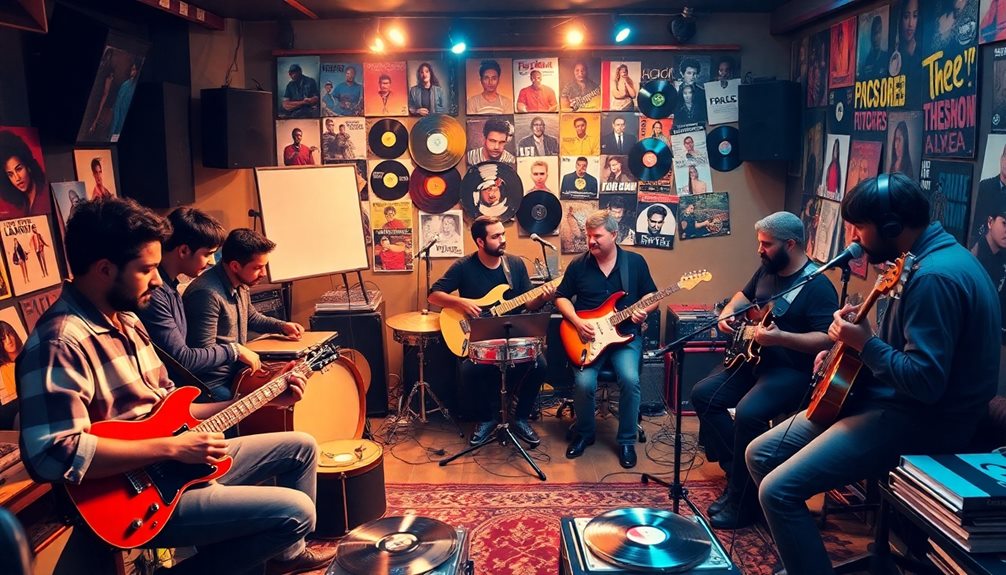
Networking and collaboration can be game-changers for your music career. When you connect with other artists, you open doors to exciting joint projects that can enhance your exposure and help you reach new audiences.
Engaging in online communities or platforms designed for artists is a fantastic way to find potential collaborators and meet industry professionals who share your passion for music. Additionally, fostering relationships and seeking feedback can lead to personal growth in your craft, as navigating life's tiny pitfalls often involves learning from others.
Don't hesitate to reach out to established artists! Collaborating with them may give you access to their fanbase and new opportunities, like being featured on their tracks. Plus, showcasing these collaborations on social media can greatly boost your visibility. It's a win-win!
Attending music industry events, like conferences and workshops, is another way to build valuable networking connections. You'll meet like-minded musicians and professionals who can inspire your creativity and help you grow your career.
Frequently Asked Questions
How Do You Distribute Your Music to Spotify?
To distribute your music to Spotify, partner with a music distributor. Upload high-quality audio files and metadata, set a release date, and utilize tools to analyze your streaming stats and audience engagement after your release.
How Do I Get My Music Released on Spotify?
To get your music released on Spotify, you'll need a distributor, but it's more than just uploading. Master your tracks, craft stunning artwork, and meticulously fill out metadata. Plan your release to maximize impact!
How Much Does It Cost to Distribute a Song on Spotify?
Distributing a song on Spotify can cost between $5 to $50, depending on the distributor you choose. You'll want to compare fees and commission structures to find what best fits your budget and needs.
How Do You Put Your Songs on Spotify?
So, you think you can just upload your songs to Spotify with a snap? Not quite! Partner with a distributor, prepare your metadata, and claim your Spotify for Artists profile to showcase your talent properly.
Conclusion
Now that you know how to get your music out there, it's time to shine! Think of distribution as planting seeds in a garden. With the right distributor, careful preparation, and a sprinkle of promotion, your music can bloom and reach listeners everywhere. Don't forget to use Spotify for Artists and check your performance metrics. Network with others, and watch your musical journey grow. So, grab your tools and start sharing your sound with the world!

